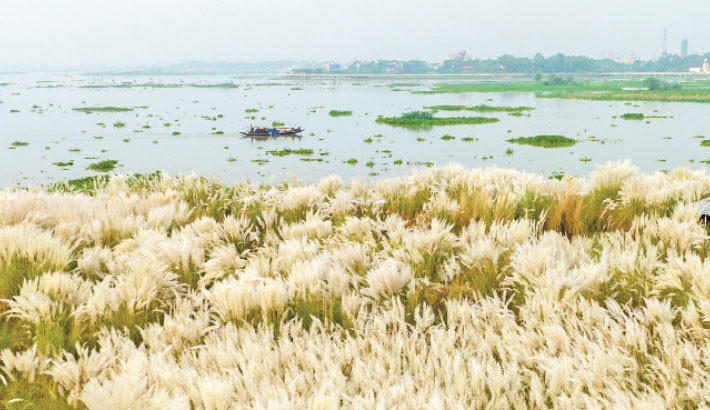Print: 29 Oct 2025
A sea of silver dreams: The bloom of kash
The banks of the River Turag in the capital’s Mirpur Beribadh area are adorned with the delicate white blooms of Kashful, swaying gently in the autumn breeze. The photo was taken recently. -SM MOSTAFIJUR RAHMAN
Autumn is drawing to a close, yet the clear blue skies and drifting white clouds still grace the horizon. Beneath them, wild stretches of kashphul (kans grass) sway gently in the breeze, enchanting onlookers with the quiet beauty of the season.
Urban nature lovers can still feast their eyes on vast kash fields in and around the capital — from Uttara’s Diabari and the Mirpur embankment to Bashundhara Residential Area, the 100 Feet Road, and Aftabnagar. The winged seeds floating through the air create a dreamlike spectacle, offering visitors moments of serene delight.
The sight of these airborne seeds gives passers-by countless opportunities to relish the spectacle. The combination of expansive fields of kashphul, their feathery plumes swaying softly in the wind, and the azure sky dotted with cotton-like clouds is enough to send anyone drifting into reverie.
Kash has many uses, but its foremost gift is its power to soothe the parched autumn days. Passing by a kashbon (kash field), one feels refreshed by its almost transcendent beauty.
The kashphul fields are also emblems of rural splendour. White seas of fluffy flower stalks carpeting newly formed lands, river shoals, and banks offer visitors a breathtaking experience. A journey through the riverine countryside or the suburban fringes evokes classic imagery from Satyajit Ray’s celebrated film Pather Panchali, where Apu and Durga – the immortalised rural siblings — run gingerly through a field of kashphul to catch a glimpse of a passing train.
Beyond their visual appeal, kashphul fields also hold economic value. They provide an important source of sustenance for marginal farmers, supplementing their meagre incomes every year. Late autumn marks the harvest season for kash – a month-long business that begins in October, with prices remaining profitable until late November.
Betel leaf growers in the northern districts prefer kashphul straw for constructing their barouj shade houses, common in lowland betel leaf cultivation. Additionally, many rural women earn a modest income by making brooms from kashphul during the late autumn months.
Kashphul (Saccharum spontaneum) is a perennial grass native to the Indian subcontinent. Standing nearly three metres tall, this aquatic plant has long been regarded as a quintessential symbol of autumn. During this season, the chhatim flower enchants with its heady, almost hypnotic fragrance, while the delicate shiuli adds to the seasonal charm. Yet, in the popular imagination, neither has ever managed to eclipse the timeless allure of kashphul.
For Bangalees, the imagery of autumn is incomplete without the sight of kash swaying in the breeze – a poetic vision that has come to define the season itself.
More From Bangladesh
More From Bangladesh
A sea of silver dreams: The bloom of kash

The banks of the River Turag in the capital’s Mirpur Beribadh area are adorned with the delicate white blooms of Kashful, swaying gently in the autumn breeze. The photo was taken recently. -SM MOSTAFIJUR RAHMAN
Autumn is drawing to a close, yet the clear blue skies and drifting white clouds still grace the horizon. Beneath them, wild stretches of kashphul (kans grass) sway gently in the breeze, enchanting onlookers with the quiet beauty of the season.
Urban nature lovers can still feast their eyes on vast kash fields in and around the capital — from Uttara’s Diabari and the Mirpur embankment to Bashundhara Residential Area, the 100 Feet Road, and Aftabnagar. The winged seeds floating through the air create a dreamlike spectacle, offering visitors moments of serene delight.
The sight of these airborne seeds gives passers-by countless opportunities to relish the spectacle. The combination of expansive fields of kashphul, their feathery plumes swaying softly in the wind, and the azure sky dotted with cotton-like clouds is enough to send anyone drifting into reverie.
Kash has many uses, but its foremost gift is its power to soothe the parched autumn days. Passing by a kashbon (kash field), one feels refreshed by its almost transcendent beauty.
The kashphul fields are also emblems of rural splendour. White seas of fluffy flower stalks carpeting newly formed lands, river shoals, and banks offer visitors a breathtaking experience. A journey through the riverine countryside or the suburban fringes evokes classic imagery from Satyajit Ray’s celebrated film Pather Panchali, where Apu and Durga – the immortalised rural siblings — run gingerly through a field of kashphul to catch a glimpse of a passing train.
Beyond their visual appeal, kashphul fields also hold economic value. They provide an important source of sustenance for marginal farmers, supplementing their meagre incomes every year. Late autumn marks the harvest season for kash – a month-long business that begins in October, with prices remaining profitable until late November.
Betel leaf growers in the northern districts prefer kashphul straw for constructing their barouj shade houses, common in lowland betel leaf cultivation. Additionally, many rural women earn a modest income by making brooms from kashphul during the late autumn months.
Kashphul (Saccharum spontaneum) is a perennial grass native to the Indian subcontinent. Standing nearly three metres tall, this aquatic plant has long been regarded as a quintessential symbol of autumn. During this season, the chhatim flower enchants with its heady, almost hypnotic fragrance, while the delicate shiuli adds to the seasonal charm. Yet, in the popular imagination, neither has ever managed to eclipse the timeless allure of kashphul.
For Bangalees, the imagery of autumn is incomplete without the sight of kash swaying in the breeze – a poetic vision that has come to define the season itself.






